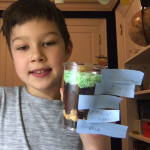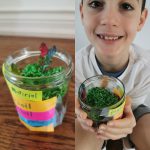This week 3B and 3C learned all about the importance of soil. Soil is so much more than what’s under our grass. Each layer of earth is defined by its own “horizon”. These horizons run parallel to the ground and serve up distinct characteristics that aid the layers above and below. When a vertical section of these many horizons is taken, it is known as a soil profile.
In class, we created a yummy edible representation of all the layers of soil. Check out our pictures below to see all of the fun we had together!
Feel free to join in on the fun this weekend! Posted below are the steps that you can take to create DIY edible soil layers!
– Ms. Offman and Mrs. Parsons
You will need:
Chocolate and butterscotch chips mixed together
Chocolate pudding
Whole Oreos, crushed Oreos
Shredded coconut mixed with green food coloring
Gummy worms
Clear cups or glasses
Spoons
Sticky post-its or labels
Step 1
Beginning with your empty glass, drop an entire Oreo into the bottom. This represents bedrock.
Bedrock: Bedrock is solid rock that lies under loose or softer material. It is the outermost layer of the Earth’s crust. Nothing can grow in bedrock, but it supplies the soil with components important to its future.
Step 2
Grab your chocolate and butterscotch chips and layer them on top of the Oreo. The chips characterize parent material.
Parent material: Parent material is formed from bedrock after a long weathering process, either by natural or chemical means. This is the spot where the soil layers above will be formed – it is part weathered rock and part weathered soil.
Step 3
Spoon in the chocolate pudding to represent subsoil.
Subsoil: Subsoil is not high in organic matter concentrations but offers rich minerals for plants and trees searching for root systems. This layer is hidden, though it is directly affected by water movement.
Step 4
On top of the subsoil goes the crushed-up Oreos, portraying topsoil. Stick the gummy worms out of the topsoil.
Topsoil: This is the top layer of soil. Topsoil provides the richest amount of matter for germinating seeds. Nutrients, bacteria, fungi, and life are abundant here.
Step 5
Sprinkle your colored coconut on top, allowing your worms to poke out.
Organic Material: This layer is usually less than an inch thick. It consists of plant and animal residues at various stages of decomposition.
Step 6
Label your layers. Look carefully at your soil profile while discussing the function of each tier. Then last but certainly not least, grab your spoon and dig in! Yum!








